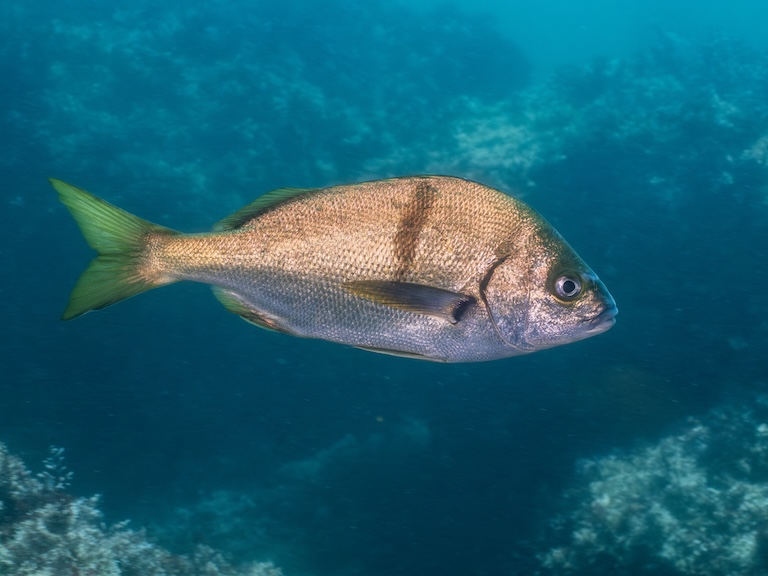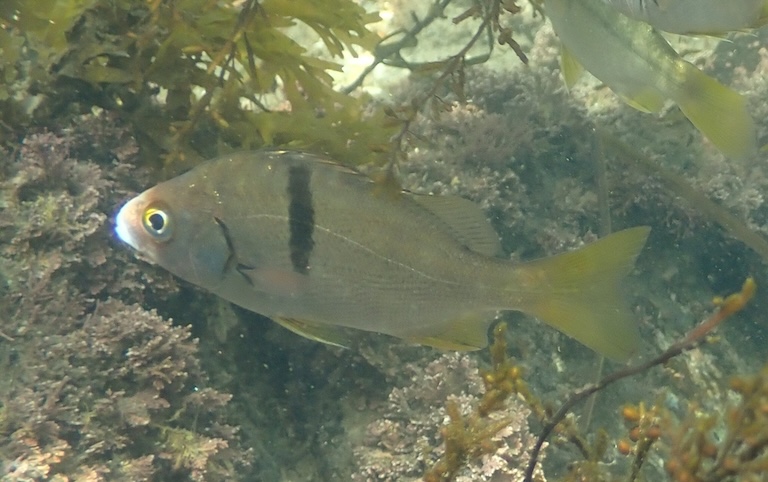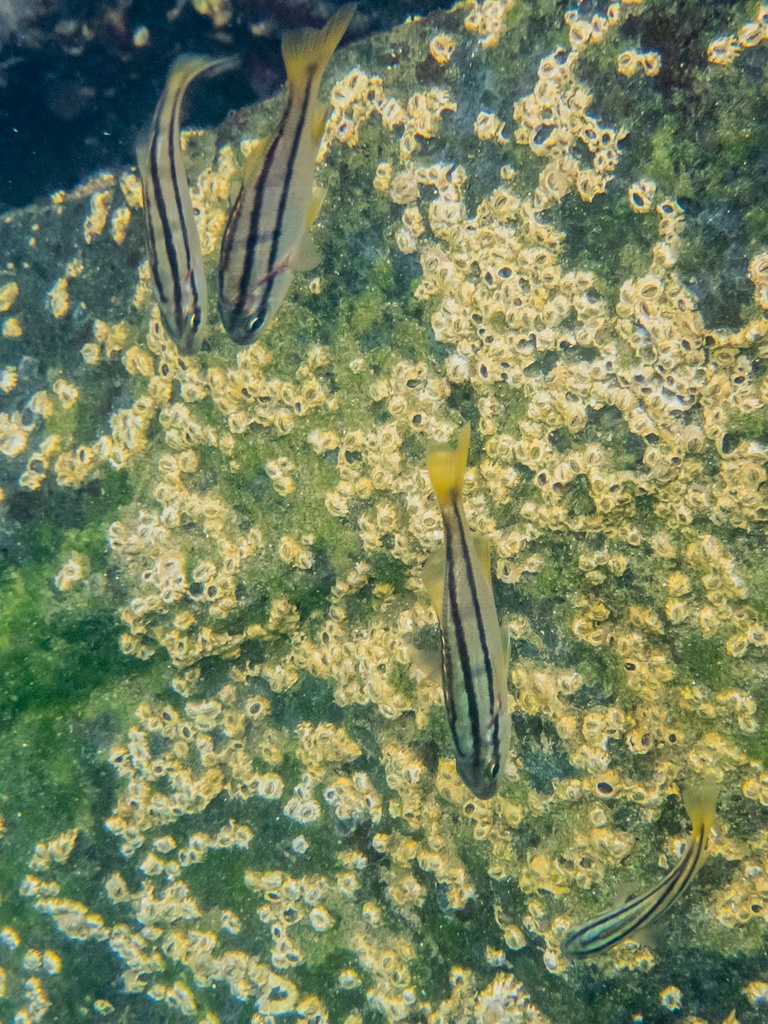Xantic Sargo Profile
The ocean is managed more or less in the same way as the road systems in the developing world: biggest goes first, and good luck because everything wants to kill you.
At the top, you’ve got the giant Cetaceans, the marine cargo trucks. The giant filter feeders are the cross-country coaches. Somewhere down the list, you’ve got the family sedans doing a school run around the reef, and then somewhere towards the bottom of the social hierarchy are the grunts, a family of pretty standard-looking fish who never learned to read and write but dream of one day winning the lottery.
The Xantic Sargo is one such fish!

Xantic Sargo Facts Overview
| Habitat: | Tropical, coastal marine, kelp beds |
| Location: | Eastern Pacific, California to Mexico |
| Lifespan: | Up to 15 years |
| Size: | Up to 60 cm (23.6 inches) in length, usually closer to half this |
| Weight: | Up to 5 kg (11 lb) |
| Colour: | Silvery, with a vertical dark stripe |
| Diet: | Small shrimps, crabs, clams, and sea snails |
| Predators: | Bigger fish |
| Top Speed: | Unknown |
| No. of Species: | 1 |
| Conservation Status: | Least Concern |
The Xantic Sargo is a very special little fish. It’s a chilled-out, crustacean-eating, kelp forest dweller that chats with its friends and hooks up with its choice of hottie to breed and generally goes about life in the way most animals would love to. And like most fish, it’s popular for all the wrong reasons.
Thankfully, its habitat is pretty well protected, so the species is likely doing fine, but this very pretty animal shows us that we still have a long way to go as a species before we care what fish are saying.
Interesting Xantic Sargo Facts
1. They’re grunts
Far from being mute and expressionless as has long been assumed, fish live vibrant social lives with friends and enemies and even vocalisations. It’s recently been established that many can use their swim bladders in a similar fashion to a cetacean’s melon, compressing it and reverberating noises through it for communication.
In the early 2000s, Mitch Hedberg observed that “If fish could scream, the ocean would be loud as shit”,1something which was later expanded upon by Peter Singer in 2010, who emphatically reminded us that “the evidence is now accumulating that commercial fishing inflicts an unimaginable amount of pain and suffering”.
So, it’s a bit of a sad fact that grunts are named after their sounds of distress when pulled out of the water. This sound doesn’t come from the swim bladder, but from the grinding of their teeth, which can be focused by the bladder when underwater.
On a lighter note, there are some fantastically-named grunts, perhaps the best of which is the French Grunt2, named after the sound made by a Parisian when asked to speak English.
The Xantic Sargo is a member of the New World genus of grunts called Anisotremus, native to the Pacific and Western Atlantic.

2. They’re social
These laterally compressed fish are very reflective, and both of these features lend themselves to shoaling or schooling behaviours. The Xantic Sargo, like other grunts, spends a lot of time in groups, and the shimmering of its scales helps to make things difficult for predators trying to isolate one from the group to eat.
The flat bodies allow for rapid changes of direction, though this isn’t a hurried animal, and is often seen cruising around without a care in the world, just hanging out with its school.

3. They’re pair bonders
Interestingly, this is one species of fish that is a little bit particular about whom they mate with. Xantic Sargos spend most of their time pecking about on the sandy sea floor in the shallows, around reefs and kelp forests, and generally travel in groups, but when it’s time to mate, they pair off and head out into more open waters to spawn.
Not a whole lot is documented about this animal’s behaviour, and like most tasty fish, the majority of its information is gathered driven by the incentives of eating more of them.
But from their ability to vocalise, their social behaviours, and their pair bonding, it wouldn’t be surprising if they turn out to be pretty clever little fish3.
4. They live in the shallows
This species feeds on small animals found in the rocks and sand, and rarely spends time in water deeper than about 65 metres. It’s said to be found chilling out motionless, likely sleeping, above the rocks during the day and to come out more at night, when it hunts more actively.
But they’re not purely nocturnal; in fact, this species and many like it are at their most beautiful when they’re cruising along in the milky blue waters as a group, just hanging out, shimmering and looking spectacular as they do it.
It should go without saying that this fish is much better observed in its habitat with its mates doing its fishy things than on the end of a hook, pleading to be let back into the water to breathe again.
5. They’re probably still doing well
This species doesn’t appear to have a widespread commercial appeal, though it’s popular among small-scale anglers in the region.
Coupled with the fact that it spends most of its time around habitats that are typically somewhat protected, like reefs and kelp forests, it’s not likely to be brought up as bycatch all that much either.
Its last assessment IUCN is very much out of date at 2007, but at that point the species was of least concern4.
Xantic Sargo Fact-File Summary
Scientific Classification
| Kingdom: | Animalia |
| Phylum: | Chordata |
| Class: | Actinopterygii |
| Order: | Acanthuriformes |
| Family: | Maemulidae |
| Genus: | Anisotremus |
| Species Name: | davidsonii |
Fact Sources & References
- Peter Singer (2010), “If fish could scream”, Project Syndicate.
- Lindeman (1977), “Bony Fishes”, fao.org.
- Steindachner (1876), “Anisotremus davidsonii”.
- Robertson et al (2010), “Xantic Sargo”, The IUCN Red List of Threatened Species in 2007.
